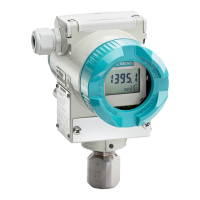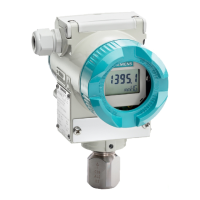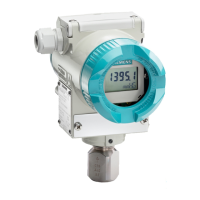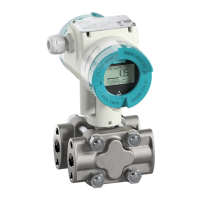
Do you have a question about the Siemens 7MF4033 series and is the answer not in the manual?
| Product Type | Pressure Transmitter |
|---|---|
| Manufacturer | Siemens |
| Communication Protocol | HART |
| Output Signal | 4 to 20 mA, HART |
| Accuracy | ±0.075% of span |
| Housing Material | Aluminum or Stainless Steel |
| Process Connection | 1/2" NPT |
| Approvals | ATEX, IECEx |
| Electrical Connection | M20 x 1.5 |
| Operating Temperature | -40°C to +85°C (-40°F to +185°F) |
Overview of measurement categories and available models.
Description of SITRANS P Series DSIII transmitters and their functions.
Information on transmitter rating, approval, and tag plates for identification.
Details on initial transmitter configuration before use.
Information on obtaining product support.
Introduction to the HART Communicator and its function.
Instructions for connecting the HART Communicator to a transmitter loop.
Overview of the HART Communicator's main functional areas and controls.
Familiarization with the HART Communicator's operation and features.
Explanation of the HART Communicator's main menu structure and options.
Guide to using the Quick Access Key for fast access to tasks.
Steps for performing a complete transmitter functional test on a test bench.
Procedures to ensure successful communication between HART Communicator and transmitter.
Steps to perform an extensive self-test on the transmitter.
How to check stored configuration data to ensure correctness before use.
Verifying transmitter output accuracy by applying known pressure inputs.
Guidelines for receiving and handling transmitter equipment upon delivery.
Prudent selection of transmitter location to minimize environmental effects.
Pre-installation checks and calculations for successful mechanical and electrical installation.
Steps for mounting differential or absolute transmitters to a pipe using a bracket.
Instructions for flange mounting liquid level transmitters directly to a vessel.
Rotating the transmitter enclosure for obstruction clearance or display viewing.
Steps to reorient the transmitter display for easier reading in different orientations.
Guidelines for routing and installing electrical conduit and cabling.
Wiring and barrier selection for installing the transmitter in hazardous locations.
List of required test equipment for post-installation verification.
Reviewing the installation to ensure correct model and certifications are used.
Connecting the test equipment as shown in the manual.
Performing communication tests, error checks, and output verification.
Commissioning methods for absolute pressure transmitters with gauge or differential construction.
Operating shutoff valves for differential pressure/flow transmitters measuring gases.
Using built-in magnetic pushbuttons and the optional digital display for local configuration.
How the local display shows measured values, units, status, mode, and output current.
How to re-enable disabled pushbuttons or cancel write protection.
Setting or adjusting zero and full scale using magnetic pushbuttons.
Adjusting the electronic damping time constant using magnetic pushbuttons.
Setting zero and full scale without applying input pressure.
Correcting zero error caused by non-vertical installation position.
Switching to a fixed current output mode for loop troubleshooting.
Setting the output current value in case of a fault or alarm.
Setting zero and full scale using magnetic pushbuttons when the display is absent or disabled.
Accessing active data for pressure, % range, analog output, and sensor temperature.
Setting zero and full scale using the HART Communicator.
Setting zero and full scale without applying reference pressure.
Correcting zero error due to installation position using HART Communicator.
Using fast response mode for applications with pressure spikes.
Enabling fixed current operation for loop troubleshooting.
Setting lower and upper fault currents for hardware or firmware failures.
Configuring the transmitter display to show output current or input pressure.
Choosing engineering units for displayed input pressure.
Configuring display modes, including bargraph function.
Procedure for trimming the lower sensor adjustment point.
Procedure for trimming the upper sensor adjustment point.
Trimming the Digital-to-Analog converter for output accuracy.
Adjusting transmitter output current to compensate for external inaccuracies.
Recalling factory calibration settings for various parameters.
Setting output current characteristics for flow measurement (linear or square root).
Activating and evaluating diagnostic functions for monitoring and calibration.
Setting timers for calibration and servicing, with warning/alarm notifications.
Monitoring transmitter current output in saturation range with limit value component.
Simulating pressure and temperature values for loop testing and training.
Initiating transmitter self-test or master reset via HART Communicator.
Discussion of position-induced zero shift and calibration procedures.
Procedures to protect transmitter reliability through periodic inspection and cleaning.
Cleaning the transmitter enclosure and process manifold with mild detergent.
Performing an annual calibration check to ensure transmitter specifications are met.
Keeping impulse piping clean and inspected for damage to ensure accuracy.
Troubleshooting common problems with the transmitter's analog output signal.
General information on removing and replacing transmitter assemblies.
Step-by-step guide for removing and installing the electronics module.
Steps for removing and replacing the terminal board assembly.
Procedures for replacing the entire transmitter unit.
Information on selecting and ordering spare and replacement parts.
Description of the transmitter's overall operation, from sensor to output.
Explanation of the pressure measuring cell and how it works.
Explanation of the flanged level measuring cell.
Description of the absolute pressure measuring cell with differential construction.
Details on the HART communication protocol and format.
Identifying transmitter models using rating and approval plates.
Listing available accessories and their compatibility.
Technical specifications for pressure, differential pressure, absolute, and level models.
Specifications for two-wire cable, including conductor size and capacitance.
Hazardous area classifications and precautions for installation.
Permitted operation with intrinsically safe circuits in hazardous locations.
Explanation of how elevation and suppression adjustments are handled via parameters.
Example calculation for determining configuration parameters for suppressed span.
An alternative method to calculations for shifting span using HART Communicator.











